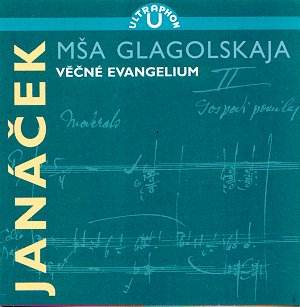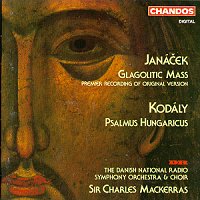Janácek
Mša Glagolskaja & Vecné
evangelium
(Glagolitic Mass & The Eternal Gospel)
 Eva
Drizgová (sop) Hana Štolfová-Bandová
(cont) Vladimir Dolezal (ten) Jiri Sulzenko
(bass) Martin Jakubiek (org) Czech Symphony
Orchestra of Brno, Leos Svárovský
Eva
Drizgová (sop) Hana Štolfová-Bandová
(cont) Vladimir Dolezal (ten) Jiri Sulzenko
(bass) Martin Jakubiek (org) Czech Symphony
Orchestra of Brno, Leos Svárovský
 Ultraphon re-released on Arcodiva UP
0011 2231, 62’21,
Ultraphon re-released on Arcodiva UP
0011 2231, 62’21,

Buy
through MusicWeb for
£10.50 postage
paid
World-wide.
Immediate delivery
You may prefer to pay by Sterling cheque
to avoid PayPal. Contact for
details
for
details
Purchase
button
It is one of the ironies of Janácek’s
Glagolitic Mass that so many previous recordings have been under Western
conductors and Western orchestras. With recordings by Bernstein, Rattle,
Mackerras and Kempe to compete with authentic interpretations by Ancerl,
Kubelik and Neumann the choice has always been a remarkably wide one.
Although the Mass seems straightforward by Janácek’s
standards it can, and should, generate enormous excitement –
both in concert and on record. Its popularity is, therefore, easy
to define. After listening to this new recording, however, I am more
convinced than ever that two distinct impressions are now at the forefront
of Janácek interpretation. The first, is that no matter how
successful some Western conductors have been in presenting the glories
of this work in graphic relief (and both Rattle and Mackerras achieve
remarkable feats) their weaknesses derive from their inability to
absorb the truly Czech nature of the work. It is impossible to emphasise
how important a native Czech choir and soloists are to the success
of the work (Rattle’s soloists are all British, for example).
The second, is that the work needs state of the art sound if it is
achieve anything near its true effect. For this reason, the Ancerl
performance is now so historical as to be out of the running (it is,
in any event, deleted from the catalogue). One of the problems with
Neumann’s reading is the poor ensemble (even though it is the
Czech Philharmonic on the podium), although the forward momentum of
the performance can never be in any doubt.
Another problem will depend on how complete you want
your Glagolitic Mass to be. It is generally considered that the revisions
to the Original score suppress much of the works dramatic power. The
original Uvod, for example, generates considerably more tension
than the published version. The rhythmic changes in Gospodi
can sully the relationship between the music and the words –
it is no longer the case that the rhythmic alterations are impossible
for choirs to sing (the original 5/4 phrasing is now within grasp
of all modern choirs). In Raspet the thrill of tripled timpani
must now be preferred to the simplified single timpani and it makes
more focused the broadening of the piccolo, brass and timpani motive.
The off stage clarinets in Veruju have now been restored –
and in any case would not be problematical in the recording studio.
More  controversially is the placing of the Intrada at the
beginning of the work as well as after the organ solo. Mackerras’
second recording of the work, with Danish forces on Chandos [CHAN
9310 Crotchet]
does place the Intrada at both the work’s opening and closing
moments. The Ultraphon recording, whilst incorporating some of the
Wingfield revisions, does not place the Intrada first at all,
only at the work’s close. The booklet note states, ‘…we
find not a single hint in any of the sources that would suggest that
this corresponded to Janácek’s own intentions.’ My
own view is that, dramaturgically, the Intrada only works at the Mass’s
close.
controversially is the placing of the Intrada at the
beginning of the work as well as after the organ solo. Mackerras’
second recording of the work, with Danish forces on Chandos [CHAN
9310 Crotchet]
does place the Intrada at both the work’s opening and closing
moments. The Ultraphon recording, whilst incorporating some of the
Wingfield revisions, does not place the Intrada first at all,
only at the work’s close. The booklet note states, ‘…we
find not a single hint in any of the sources that would suggest that
this corresponded to Janácek’s own intentions.’ My
own view is that, dramaturgically, the Intrada only works at the Mass’s
close.
Svárovský’s new recording is in
every way a thrilling performance of the Glagolitic Mass. Not only
are the great orchestral interludes beautifully played, but there
is a symbiotic relationship between them and the great choral sections.
A successful recording of this thrilling work rests entirely or otherwise
on the four soloists. Vladimir Dolezal is a virile and heroic tenor
(after his entry in the Slava the performance becomes incredibly taut).
The voice rings like the clearest bell. Eva Drízgová
produces a searing tone, bright like gilt, although without perhaps
the striking individuality of expression that Felicity Palmer brings
to Rattle’s version. In terms of diction, which is so important
in this work, Drízgová is well ahead of her rivals –
even Mackerras’ otherwise outstanding Elizabeth Söderström
on his first recording. Where the performance comes out strongest
is in the chorus’ perfect synchronicity with the orchestral interludes.
This is one reason why Rattle’s performance is ultimately unsatisfactory.
If there is a mild disappointment with this new release
it is the recording given to the organ solo which seems slightly recessed.
Generally, however, this new recording can stand in the same illustrious
company as Mackerras I and II and, for many, might be a first choice
given the spacious and dramatic engineering on this disc.
The coupling is an intensely moving performance of
Vecné evangelium - The Eternal Gospel.
There has previously been only one recording of this twenty minute
work, by the Czech Symphony Orchestra under Pinkas (previously on
Supraphon but now deleted) so this new recording is your only opportunity
to hear it. Compared to Janácek's other choral works, The Eternal
Gospel is not based on religious texts (such as the Mass) and nor
does it tell a story, as does, for example, the cantata Amarus. Written
in 1914 (before the outbreak of the First World War, but clearly influenced
by the events leading up to it), the work is a legend based on the
12th century visionary Joachim of Fiore who preached his eternal gospel
of universal love ; in style, however, and perhaps again influenced
by impending war, the piece looks forward to some of Janácek's
later works, notably the opera From the House of the Dead.
That opera's sparse, almost naked scoring, owes something
to the very opening movement of The Eternal Gospel. Here we have a
solo violin emerging almost imperceptibly from low strings with only
the slightest use of brass to brighten the tone. It has an eeriness
which almost defies the movement's description of 'attacca'. The most
extraordinary movement, however, is the third (and longest) which
more than a little resembles Prokofiev's startling cantata Alexander
Nevsky, not least the soprano lament From the Field of the Dead. Here
Drízgova's bright soprano voice is evocatively set against
the burnished tenor of Vladimir Dolezal. The entry of the chorus for
the Allelujah is a moment of pure exultation, the great brass chorales
acting as a contrast to the high, figurative sopranos emerging from
the choir.
The booklet note, whilst giving us a translation of
the text of The Eternal Gospel (none for the Mass, however) does not
divide the movements into soprano, tenor or choral roles, despite
the fact that each movement contains elements of each. It is a drawback
- but not as serious as the booklet's general reluctance to give us
any information at all about the performance versions used in this
recording.
Mackerras' second recording of the Glagolitic Mass
has as its coupling Kodaly's Hungarian Psalm, a fine performance to
accompany his world premiere recording of the original version of
the Mass. This new Ultraphon recording offers a rare performance of
one of Janácek's unknown glories and this will probably make
it the first choice for many. Despite the problems many will have
in hunting it down, it offers authentic, dramatic performances in
outstanding sound. Highly recommended.
Marc Bridle
The
Arcodiva catalogue is now offered by MusicWeb
